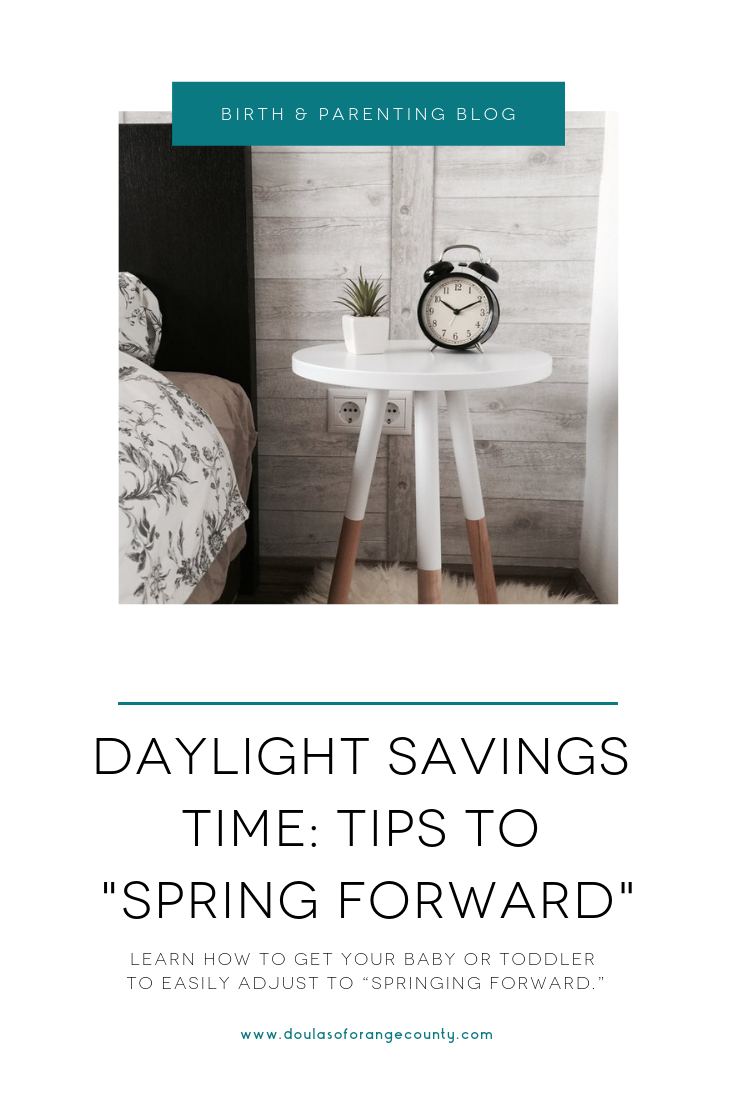As the time change approaches, more and more parents are reaching out to us to chat about how to get their baby or toddler to easily adjust to “springing forward.” It’s my opinion that this is the easier of the two time changes, especially when you have kiddos! Despite it being easier than “falling back”, it can still be helpful to have a plan in place to minimize disruptions and keep your day-to-day schedule flowing nicely.
These are general tips that will work for most families with babies 4+ months through adolescence. If you’re interested in a personalized sleep assessment with clear goals to stick to as we approach the time change, you can schedule a 90-minute video call with me to assess your baby’s sleep.
4 Tips for Daylight Savings Time
Ease into the Change
For many children (especially young babies), adjusting to the one hour time change can be overwhelming. Easing your child into to the new bedtime before the actual time change occurs can make things quite a bit easier. The idea here is to adjust your child’s schedule bit by bit so that once the time actually changes your kiddo’s 6 p.m. becomes 7 p.m. and he or she will already be used to the new schedule.
So how does this work? It’s pretty simple actually! 5-7 days before the time change, adjust the schedule in 15-20 minute increments. Begin putting your child to bed 15 to 20 minutes earlier until you reach a full hour of total change. So, if your child’s bedtime is currently 7:00pm, shift bedtime at 6:40 p.m., then 6:20 p.m., then 6:00 p.m. For smaller babies, 15 minute increments tend to be better.
Prioritize Naps
Sleep begets sleep. If you aren’t a believer in this age old adage, become one now because it is so true!! The more daytime sleep your little one gets, the easier bedtime will be during the time change. It is really important to make sure your baby is getting good naps for the few days before the time shift, as well as on the days immediately following the time shift. A healthy amount of daytime sleep helps take the edge off of the discomfort associated with drastic changes. I also recommend moving naps back 15-20 minutes at a time along with bedtime to help keep the schedule consistent & seamless.
Use Light to Your Advantage
Regardless of how you choose to ride out the scheduling aspect of the time change, we highly recommend using light (and dark) to help you adjust to the new normal. Lots of exposure to light in the morning will help your child’s internal clock to adjust. Plan on getting out of the house for a nice walk or outdoor play first thing. If it’s rainy, keep the curtains open and play near the windows as much as possible.
As the days will now get longer so will the brightness at night. And until your baby’s circadian rhythm fully adjusts to the new time, it’s going to work to your advantage if you have some blackout curtains. Use them for naps and bedtime to help them sleep more soundly. I also recommend closing the blinds/curtains in your living areas in the evening before bedtime and dim the lights for about an hour before bedtime for at least the first week or so after we spring forward. The dimmer lighting helps trigger melatonin production and sends signals to your child’s brain that it’s almost time for sleep.
If your older child uses an alarm clock or tot clock (like these), you can set the new time an hour later. These types of clocks work best when they’re used consistently, especially before any major schedule changes.
Stay Tuned In
Even if your child is a pro at this whole sleeping thing, the time change may still throw off the schedule. For both naps and bedtime, be sure to pay close attention to your child’s wakeful windows and sleepy cues. If you choose to move naps backwards along with bedtime, you’ll want to maintain the same amount of time between naps and bedtime to ensure the smoothest transition of your entire schedule. Always err on the side of caution if it seems like your child is getting overtired. Being overtired makes things all the more difficult especially for babies, so don’t try to overstretch your baby for the sake of bedtime or nap time being a specific set time. Stay tuned into your baby as well as the clock and make your decision based on the two factors together. It’s ok if the timing isn’t exactly right, over time your baby will adjust to the new schedule and things will find their rhythm again.
Having a plan is the best thing to help you and your entire family make it through the time change unscathed. Always, always manage your energy and be patient when implementing changes to the schedule. Your kiddos feed off your energy, so if you’re stressed and overtired, they will be too. Be gentle with the adjustments and take deep breaths. Know that even if things don’t go according to plan perfectly, you’ll get sleep back on track and into this new rhythm in time.
How do you help your child adjust to time or schedule changes?



